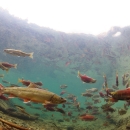States
MontanaThis initiative will improve connectivity for native trout in Montana by creating fish passage fish passage
Fish passage is the ability of fish or other aquatic species to move freely throughout their life to find food, reproduce, and complete their natural migration cycles. Millions of barriers to fish passage across the country are fragmenting habitat and leading to species declines. The U.S. Fish and Wildlife Service's National Fish Passage Program is working to reconnect watersheds to benefit both wildlife and people.
Learn more about fish passage at three diversions and one culvert. The project locations are in long term, climate resilient priority watersheds for bull trout and arctic grayling. The projects will open almost 20 miles of upstream habitat. The North Fork Blackfoot River project will replace water supply from the river with groundwater, restoring flow to over a mile of river, and the Poorman Creek AOP replaces a culvert with a larger fish friendly crossing, both for bull trout. The McVey Creek project installs step-pools on two private diversions and the Middle/West project creates pool/riffles to gain passage, both for Arctic Grayling. In addition to benefitting the species, these projects will create stable diversions for local agriculture, buffering the community against potential loss of crops due to climate change climate change
Climate change includes both global warming driven by human-induced emissions of greenhouse gases and the resulting large-scale shifts in weather patterns. Though there have been previous periods of climatic change, since the mid-20th century humans have had an unprecedented impact on Earth's climate system and caused change on a global scale.
Learn more about climate change and contributing local economic development.
Quick Facts:
Project Status | Active |
Location | MT, Powell/Lewis & Clark/Beaverhead |
NFPP Project Funding | $250,000 |
Restoration Techniques | Culvert Replacement, Fish Passage Diversions |
Accomplishments | 20 Stream Miles Reopened |
Project Partner Lead | Big Blackfoot Chapter of Trout Unlimited |
Primary Species Benefited | Bull Trout |
The National Fish Passage Program combines technical expertise with a track record of success.
Implemented primarily through the Service's Fish and Wildlife Conservation Offices, the National Fish Passage Program provides financial and technical assistance to partners across the country. Since 1999, the program has worked with over 2,000 local communities, Tribes, and private landowners to remove or bypass over 3,400 barriers to fish passage and reopen access to over 61,000 miles of upstream habitat for fish and other animals. Staff have expertise in fish migration and biology as well as financial, engineering, and planning assistance to communities, Tribes, and landowners to help them remove barriers and restore rivers for the benefit both fish and people.
Fish passage project proposals can be initiated by any individual, organization, government, or agency. However, proposals must be submitted and completed in cooperation with a Fish and Wildlife Conservation Office. (Please note that fish passage projects being used for federal or state compensatory mitigation or required by existing federal or state regulatory programs are not eligible for funding through the National Fish Passage Program.)
CONTACT A FISH PASSAGE COORDINATOR IN YOUR AREA TO GET STARTED.


